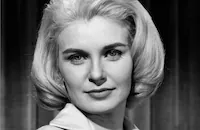Signpost to Murder

Brief Synopsis
Cast & Crew
George Englund
Joanne Woodward
Stuart Whitman
Edward Mulhare
Alan Napier
Joyce Worsley
Film Details
Technical Specs

Synopsis
Alex Forrester, convicted of murdering his wife, fails to gain his release after spending 10 years in a British asylum for the criminally insane. Dr. Mark Fleming, Forrester's psychiatrist, informs him of an old law which provides for the reopening of a trial if the prisoner escapes and remains at large for 14 days. Forrester escapes and takes refuge in the home of Molly Thomas, who claims that she is awaiting the return of her husband from a trip to The Hague. Molly tells him of her unhappy marriage, and the two become attracted to each other. In the evening, Forrester discovers a man's body by the mill wheel of Molly's house. After stumbling down a flight of steps, he regains consciousness and finds that the body is missing. The corpse is later found by the police, and Molly identifies the dead man as her husband. She accuses Forrester of the murder but later breaks down and informs the police that she and Fleming are lovers and that they arranged Forrester's escape in order to frame him for the murder.

Director
George Englund
Cast

Joanne Woodward
Stuart Whitman
Edward Mulhare

Alan Napier
Joyce Worsley
Leslie Denison
Murray Matheson
Hedley Mattingly

Carol Veazie
Crew
Sally Benson
George W. Davis
Henry Grace
Sydney Guilaroff
J. Mcmillan Johnson
Frank Mckelvy
John Mcsweeney Jr.
Franklin Milton
Lyn Murray
Travilla
William Tuttle
Paul C. Vogel
Lawrence Weingarten
Wallace Worsley

Film Details
Technical Specs

Articles
Signpost to Murder
After this trajectory of roles, the Georgia-born actress began making some very unexpected choices with her career. In between frequent projects with her husband (who either co-starred with her or directed her), she chose unorthodox films like the twist-filled quasi-western, A Big Hand for the Little Lady (1966), or two years earlier, a swift and tricky thriller called Signpost to Murder (1964).
Based on an English play by Monte Doyle that originally featured Margaret Lockwood onstage, the film casts Woodward as Molly Thomas, a married woman waiting for her husband to come back from a business trip abroad. Her solitude is broken by the arrival of Alex Forrester (Stuart Whitman), a convict who's been confined to a mental institution for the past decade; he is now on the run under the advice of his psychiatrist (Edward Mulhare), who has brought up a legal loophole which allows a court to reopen a murder case if the convicted party remains at large for two weeks. The unlikely pair grow attracted to each other, until a dead body turns up...
Filled with unexpected twists and turns, this independent production was picked up by MGM for theatrical distribution complete with the lurid tagline, "Are we all potential killers? Don't watch this picture if you are afraid of what it may reveal about yourself!" Strikingly lensed in black-and-white Panavision by veteran cinematographer Paul Vogel (The Time Machine, 1960), the film clocks in much shorter than average considering its pedigree; at 74 minutes, it's extremely spare and even leaner than the source play.
Like his leading lady with whom he had worked earlier on The Sound and the Fury, Whitman had also spent much of his career doing TV work in the '50s. By this point he had also made the full jump to leading man status with films like the 1964 thriller Shock Treatment (in which he also endured a stay in a mental hospital), and that same year's ambitious western, Rio Conchos. He had also earned an Oscar® nomination for 1961's The Mark and, as a trained boxer, had earned a reputation as one of the most reliable rugged actors around. He remained steadily employed, alternating between TV series and action and horror films (including work for Hammer Films and Roger Corman), until his retirement in 2000.
As for the third part of what amounts to essentially a three-character mystery, Edward Mulhare is perhaps the most familiar to '80s TV viewers for his recurring role as Devon Miles on Knight Rider, not to mention a long list of guest appearances and a hammy role in the 1982 box office disaster turned cult classic, Megaforce. He was mainly known as strictly a TV actor at the time he made Signpost to Murder, but afterwards he followed it with some intriguing big screen choices like Our Man Flint (1966), the eerie horror/art film Eye of the Devil (1966), and the mod 1967 Doris Day spy caper, Caprice. Next to co-starring with David Hasselhoff, the urbane Irish thespian's most enduring role in pop culture is his two-year stint as Captain Gregg in the TV version of The Ghost & Mrs. Muir opposite Hope Lange, which ran from 1968 to 1970. The original film's role had been originated by Rex Harrison, an actor Mulhare had followed earlier as understudy and then successor in the original Broadway run of My Fair Lady.
Producer: Lawrence Weingarten
Director: George Englund
Screenplay: Sally Benson; Monte Doyle (play)
Cinematography: Paul C. Vogel
Art Direction: Edward Carfagno, George W. Davis
Music: Lyn Murray
Film Editing: John McSweeney, Jr.
Cast: Joanne Woodward (Molly Thomas), Stuart Whitman (Alex Forrester), Edward Mulhare (Dr. Mark Fleming), Alan Napier (The Vicar), Joyce Worsley (Mrs. Barnes), Leslie Denison (Superintendant Bickley), Murray Matheson (Dr. Graham), Hedley Mattingly (Police Constable Mort Rogers), Carol Veazie (Auntie).
BW-78m. Letterboxed.
by Nathaniel Thompson

Signpost to Murder
Quotes
Trivia
Notes
Some location scenes filmed in England.

Miscellaneous Notes
Released in United States Winter January 1, 1965
Released in United States Winter January 1, 1965














